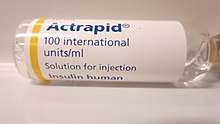Regular insulin
Regular insulin, also known as neutral insulin and soluble insulin is a type of short acting insulin.[2] It is used to treat diabetes mellitus type 1, diabetes mellitus type 2, gestational diabetes, and complications of diabetes such as diabetic ketoacidosis and hyperosmolar hyperglycemic states.[3] It is also used along with glucose to treat high blood potassium levels.[4] Typically it is given by injection under the skin, but may also be used by injection into a vein or muscle.[2] Onset of effect is typically in 30 minutes and they last for 8 hours.[3]
 A vial of regular human insulin | |
| Clinical data | |
|---|---|
| Trade names | Humulin R, Novolin R, Actrapid, others[1][2] |
| Other names | insulin injection (soluble),[2] neutral insulin,[2] regular human insulin, human insulin (regular) |
| AHFS/Drugs.com | Monograph |
| MedlinePlus | a682611 |
| Pregnancy category |
|
| Routes of administration | subcutaneous, intramuscular, intravenous[2] |
| ATC code | |
| Legal status | |
| Legal status |
|
| Pharmacokinetic data | |
| Onset of action | 30 minutes |
| Duration of action | 8 hours |
| Identifiers | |
| CAS Number | |
| ChemSpider |
|
The common side effect is low blood sugar.[3] Other side effects may include pain or skin changes at the sites of injection, low blood potassium, and allergic reactions.[3] Use during pregnancy is relatively safe for the baby.[3] Regular insulin can be made from the pancreas of pigs or cows.[2] Human versions can be made either by modifying pig versions or recombinant technology.[2]
Insulin was first used as a medication in Canada by Charles Best and Frederick Banting in 1922.[5] It is on the World Health Organization's List of Essential Medicines, the most effective and safe medicines needed in a health system.[6] The wholesale cost in the developing world is about US$2.39–10.61 per 1,000 iu of regular insulin.[7] In the United Kingdom 1,000 iu costs the NHS £7.48, while in the United States this amount is about $134.00.[2][8] In 2016 it was the 84th most prescribed medication in the United States with more than 8 million prescriptions.[9] Versions are also available mixed with longer-acting versions of insulin, such as NPH insulin.[2]
Medical uses
Regular insulin is used for the long-term management of diabetes.[3] It is the treatment of choice for the two diabetic emergencies diabetic ketoacidosis and hyperosmolar hyperglycemic states.[3] It may also be used in combination with glucose to lower potassium levels in those with hyperkalemia.[4]
Side effects
Side effects may include: low blood sugar levels, skin reactions at the site of injection and low potassium levels among others.[3]
Manufacture
Humulin, one brand name for a group of biosynthetic human insulin products, is synthesized in a laboratory strain of Escherichia coli bacteria which has been genetically altered with recombinant DNA to produce biosynthetic human insulin. Humulin R consists of zinc-insulin crystals dissolved in a clear fluid.
Formulations
It is currently sold by many manufacturers in a number of different forms.
By Eli Lilly these include:
- Humulin R (REGULAR human insulin injection [rDNA origin]) is a short-acting insulin that has a relatively short duration of activity as compared with other insulins.
- Humulin R Regular U-500 (Concentrated) insulin human injection, USP (rDNA Origin) is a stronger concentration (500 units/mL) of Humulin R.
- Humulin 70/30 (70% human insulin isophane suspension, 30% human insulin injection [rDNA origin]) is a mixture insulin. It is an intermediate-acting insulin combined with the onset of action of Humulin
- Humulin 50/50 (50% human insulin isophane suspension, 50% human insulin injection [rDNA origin]) is a mixture insulin. It is an intermediate-acting insulin combined with the onset of action of Humulin R.
In UK these include:[10]
- Actrapid
- Humulin S
- Insuman Rapid
References
- "insulin regular human (OTC) – Humulin R, Novolin R". Archived from the original on 16 December 2014. Retrieved 1 December 2014.
- British national formulary : BNF 69 (69 ed.). British Medical Association. 2015. p. 464472. ISBN 9780857111562.
- American Society of Health-System Pharmacists. "Insulin Human". www.drugs.com. Archived from the original on 22 October 2016. Retrieved 1 January 2017.
- Mahoney, BA; Smith, WA; Lo, DS; Tsoi, K; Tonelli, M; Clase, CM (18 April 2005). "Emergency interventions for hyperkalaemia". The Cochrane Database of Systematic Reviews (2): CD003235. doi:10.1002/14651858.CD003235.pub2. PMC 6457842. PMID 15846652.
- Fleishman JL, Kohler JS, Schindler S (2009). Casebook for The Foundation a Great American Secret. New York: PublicAffairs. p. 22. ISBN 978-0-7867-3425-2. Archived from the original on 18 January 2017.
- "WHO Model List of Essential Medicines (19th List)" (PDF). World Health Organization. April 2015. Archived (PDF) from the original on 13 December 2016. Retrieved 8 December 2016.
- "Insulin, Neutral Soluble". International Drug Price Indicator Guide. Retrieved 8 December 2016.
- "NADAC as of 2016-12-07 | Data.Medicaid.gov". Centers for Medicare and Medicaid Services. Archived from the original on 21 December 2016. Retrieved 17 January 2017.
- "The Top 300 of 2019". clincalc.com. Retrieved 22 December 2018.
- "Human Insulin - Types, Production, Action, History". Retrieved 17 November 2017.